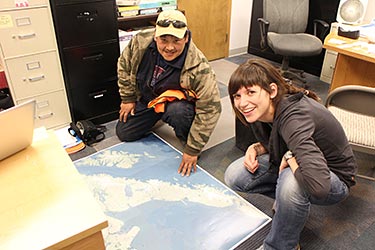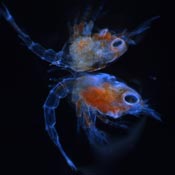Alaska Sea Grant 2012–2014 Project Directory
Research and information on Alaska coastal and marine issues
As part of our core mission to help Alaskans understand, conserve, and sustainably use our rich and diverse marine and coastal resources, Alaska Sea Grant supports a number of formal, peer-reviewed research projects through a biennial call for proposals.
Through each RFP, we seek creative and innovative research proposals in the natural and social sciences that focus on the environmental and economic viability of Alaska's coastal communities. For 2012–2014, we selected proposals that addressed either of two themes:
- Impacts on and strategies for coastal ecosystems and/or coastal communities adapting to change.
- Improvements to the economic and sociocultural sustainability of Alaskan coastal communities.
In addition to their scientific merit, and relevance to the themes above, research projects must contribute to one or more of our strategic focus areas and incorporate a significant program of outreach to communities or stakeholders. Additional favorable consideration is given to proposals that:
- Increase their impact through critical linkages, such as the linkage of ecosystem research to broader sociocultural or management issues.
- Include graduate students who will become the next generation of scientists and managers.
- Make efficient use of funds through leveraging, partnerships, or new uses of existing data or techniques.
- Include meaningful collaboration with industry, agencies, communities, or other stakeholders.
For 2012–2014, we funded four projects as listed below. To read about projects from previous funding cycles, see our research archives.
NOTE: The linked titles below go to each project's summary web page in our research project database. To return to this project directory, use your web browser's BACK button.
Projects
Collaborative Research: Building Capacity for Community-based Marine Mammal Conservation in Bristol Bay [R/112-01]
- Chanda Meek, College of Liberal Arts, University of Alaska Fairbanks
- Helen Aderman, Bristol Bay Native Association
Focus area: Healthy Coastal Ecosystems
Please see the Imarpim Ungungsiit (Marine Mammal) Project for additional information.
 The focus of many research programs sometimes is not broad enough to address concerns important to Alaska coastal communities. Specifically, communities have repeatedly requested studies that address the availability of resources to local communities, as well as efforts to monitor habitat quality in the marine environment. In this project, researchers will expand a Bristol Bay Native Association pilot project aimed at documenting the ways in which marine mammal ecology and harvesting patterns among hunters have changed over time. In this expanded project, researchers will examine sea otters and bearded seal hunting patterns among subsistence hunters in the Bristol Bay communities of Togiak and Port Heiden, and in the Alaska Peninsula community of Chignik Lagoon. Researchers will use the traditional knowledge they collect as well as archival data and field surveys to add to maps that illustrate past and current areas important for subsistence as well as marine conservation.
The focus of many research programs sometimes is not broad enough to address concerns important to Alaska coastal communities. Specifically, communities have repeatedly requested studies that address the availability of resources to local communities, as well as efforts to monitor habitat quality in the marine environment. In this project, researchers will expand a Bristol Bay Native Association pilot project aimed at documenting the ways in which marine mammal ecology and harvesting patterns among hunters have changed over time. In this expanded project, researchers will examine sea otters and bearded seal hunting patterns among subsistence hunters in the Bristol Bay communities of Togiak and Port Heiden, and in the Alaska Peninsula community of Chignik Lagoon. Researchers will use the traditional knowledge they collect as well as archival data and field surveys to add to maps that illustrate past and current areas important for subsistence as well as marine conservation.
This project was featured in the news story “Graduate student documents traditional knowledge from Alaska Native hunters”.
Nutrition and Condition of Red King Crab Larvae: Enhancement of King Crabs to Improve Sustainability of Alaskan Coastal Communities [R/34-02]
- Ginny Eckert, Fisheries Division, School of Fisheries and Ocean Sciences, University of Alaska Fairbanks
Focus area: Safe and Sustainable Seafood Supply
 Alaska king crabs are iconic, historically important species in many regions for sport, subsistence, and community harvest. Almost all of the historical king crab fisheries in Alaska crashed and are now closed. The lack of recovery in stocks, such as Kodiak red king crab and Pribilof Islands blue king crab, which have not recovered in the absence of fishing for decades, suggests that alternative approaches are needed to rebuild king crab stocks in Alaska. King crab enhancement has the potential to restore king crab stocks, which would economically benefit the fishing industry and coastal communities throughout Alaska. The recent success of king crab culture in Alaska suggests that enhancement with hatchery animals is possible, yet mortality during the last larval rearing stage is a bottleneck in hatchery production of juveniles. In this project researchers will test whether a larval nutritional deficiency is the source of the bottleneck.
Alaska king crabs are iconic, historically important species in many regions for sport, subsistence, and community harvest. Almost all of the historical king crab fisheries in Alaska crashed and are now closed. The lack of recovery in stocks, such as Kodiak red king crab and Pribilof Islands blue king crab, which have not recovered in the absence of fishing for decades, suggests that alternative approaches are needed to rebuild king crab stocks in Alaska. King crab enhancement has the potential to restore king crab stocks, which would economically benefit the fishing industry and coastal communities throughout Alaska. The recent success of king crab culture in Alaska suggests that enhancement with hatchery animals is possible, yet mortality during the last larval rearing stage is a bottleneck in hatchery production of juveniles. In this project researchers will test whether a larval nutritional deficiency is the source of the bottleneck.
Developing High-Resolution Strontium Isotope Maps of Alaska Rivers to Track Pacific Salmon Migrations: The Nushagak River as a Case Study to Evaluate Spatial and Seasonal Variability [R/100-02]
- Matthew Wooller, Water and Environmental Research Center, Institute of Northern Engineering
Focus area: Healthy Coastal Ecosystems
Alaska's fisheries managers need cost effective, accurate, and reliable tools to accurately identify the birthplace, called natal tributaries, of adult salmon harvested in mixed-stock commercial fisheries. In this case study of the Nushagak River in southwest Alaska's Bristol Bay, researchers will examine the feasibility of using strontium (87Sr/86Sr) isotope signatures found in Nushagak River tributaries and those found in salmon otoliths to identify the fine-scale tributary-level origins of adult salmon. If successful, this study could result in an important new tool to effectively manage the region's commercial salmon fisheries, which generate more than $2.9 billion in local harvesting and processing-related economic activity. This study will be the first thorough attempt to resolve salmon mixed-stock fisheries in Alaska rivers using isotopic data integrated with genetic data.
For more information, see the 2014 news story “Student’s strontium isotope project offers a new map of Alaska”.
Impacts of Sea Otter Recolonization on Marine Resources and Coastal Communities in Southern Southeast Alaska [R/111-02]
- Allison Rice, Marine Advisory Program, University of Alaska Fairbanks
- Ginny Eckert, Fisheries Division, School of Fisheries and Ocean Sciences, University of Alaska Fairbanks
Focus area: Healthy Coastal Ecosystems
Please see The Southern Southeast Alaska Sea Otter Project website and Alaska Sea Grant News page for additional information.
This project continues the Alaska Sea Grant project launched in 2010 to investigate the impacts of sea otter recolonization on four commercially important species and their associated fisheries (southeast Alaska sea cucumbers, red sea urchins. Dungeness crab, and geoduck clams). This project will provide stakeholders, resource managers, and policy makers with information needed to consider the impacts of a marine mammal predator on commercially important fisheries.


